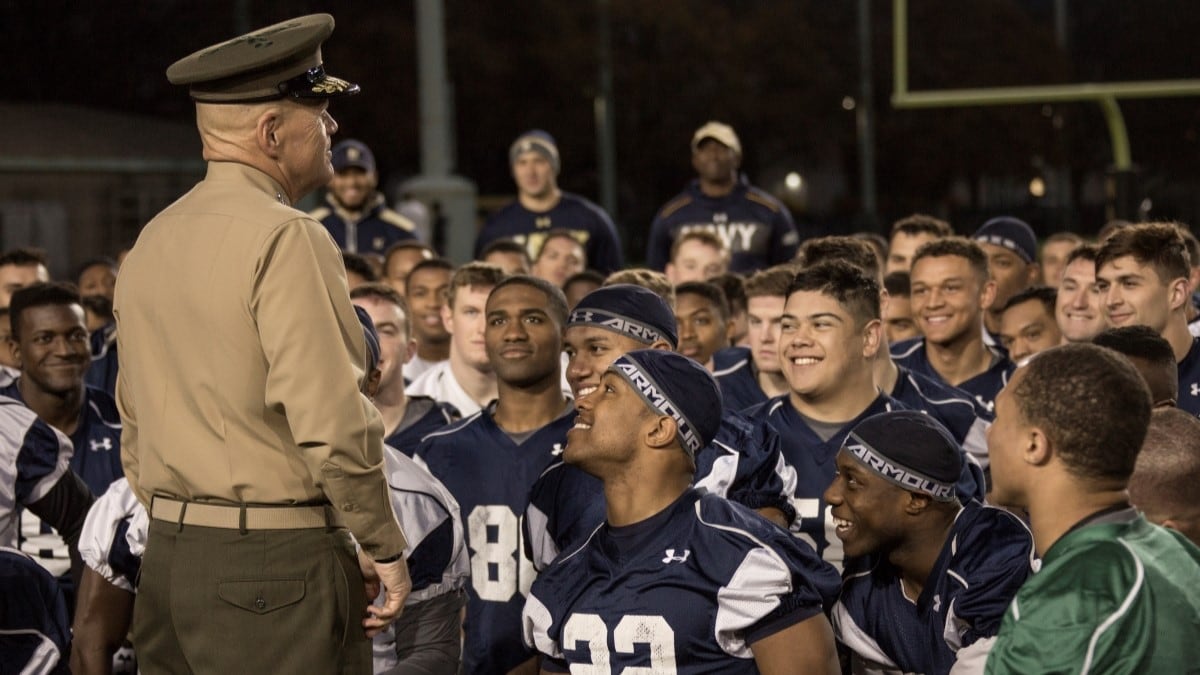Capt. Adam West already had plenty of reasons to become a Marine.
He had a family legacy of service in the Marine Corps, including an uncle and a cousin who were killed in action. He had grown up seeing the iconic images of the wars in the Middle East, with Marines bearing rifles, doing tough work.
But for the former U.S. Naval Academy football team offensive guard, there also was the yearning for a challenge. The sense that he could use his experience in a combative sport for a greater purpose.
“The Marine Corps brand is not welcoming, which is perhaps the most charming thing about it,” said West, who is currently stationed at Marine Barracks Washington. “They’re not interested in you. It’s, ‘Can you keep up?’”
Each year, a strikingly large portion of the Naval Academy’s football team decides to answer that question and pursue the Marine officer route.
Since 2014, 46% of the players have become Marines, according to academy spokesman Scott Strasemeier. That’s compared to only 25% to 30% of Naval Academy midshipmen overall.
In November, 10 out of the 25 football players in the Class of 2024 received Marine Corps assignments, according to Strasemeier.
West, a 2017 Naval Academy graduate, said the football players, himself included, tend to be drawn to the higher physical and other standards of the Marine Corps, though he noted has great respect for the Navy and the people who join the service.
Football’s high-contact nature has something in common with the Marine ethos, West said — in particular the infantry, where several of his teammates ended up.
“I don’t want to compare football to real-life combat operations, but if you’re a football player who’s trained to think that way and use your skills in that way, it turns out a lot of the Marine Corps’ mission is hands-on, imposing your will on someone directly,” West said.
The message then-Navy coach Ken Niumatalolo had for his players also aligned with Marine Corps culture, according to West: Be disciplined, be detail-oriented, and find a way to win.
In West’s view, the team’s legacy of Marine Corps service is another reason many of the players are inspired to trade in their cleats for eagle, globe and anchor pins.
There was 1st Lt. Ronald Winchester, who was killed in Iraq in September 2004. There was 2nd Lt. J.P. Blecksmith, killed in Iraq in November 2004.
There was Brian Stann, who earned the Silver Star Medal for the valor he showed as a second lieutenant in Iraq in May 2005.
There was retired Capt. Bryce McDonald, who returned to the team as a coach after surviving an improvised explosive device flipping his Humvee in Iraq in 2006, as the Los Angeles Times reported.
Four of the team’s current staff members are Naval Academy grads who became Marines, according to Strasemeier.
The large number of future Marines on the team is sometimes obvious at a glance, West said.
On Nov. 19, 2016, days before the football team played East Carolina University, the academy’s seniors received their service assignments. That meant West and other soon-to-be Marines had to get their heads shaved, as a traditional rite of passage.
When the dress-uniform-clad midshipmen arrived in North Carolina, half of them were sporting freshly razor-shorn heads.
The intimidation factor was high, West recalled.
“The ECU fans were amused to see midshipmen players arriving in uniform but became a little bit unsettled at the sight of the Marine selects with bald heads offloading the buses,” West said.
The Midshipmen beat East Carolina that day, 66–31.
Irene Loewenson is a staff reporter for Marine Corps Times. She joined Military Times as an editorial fellow in August 2022. She is a graduate of Williams College, where she was the editor-in-chief of the student newspaper.





